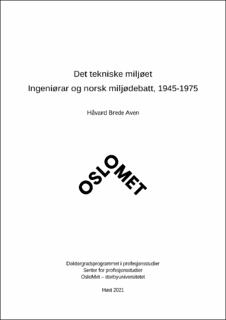| dc.contributor.advisor | Nygaard, Pål | |
| dc.contributor.advisor | Thue, Fredrik W. | |
| dc.contributor.author | Aven, Håvard Brede | |
| dc.coverage.spatial | Norge | en_US |
| dc.date.accessioned | 2021-11-29T09:34:36Z | |
| dc.date.available | 2021-11-29T09:34:36Z | |
| dc.date.issued | 2021 | |
| dc.identifier.isbn | 978-82-8364-324-4 | |
| dc.identifier.isbn | 978-82-8364-356-5 | |
| dc.identifier.issn | 2535-5414 | |
| dc.identifier.uri | https://hdl.handle.net/11250/2831832 | |
| dc.description.abstract | Denne avhandlinga handlar om debattar om globale miljøproblem blant norske ingeniørar i perioden mellom 1945 og 1975, og korleis enkelte ingeniørar deltok i breiare, offentlege ordskifte om miljøproblem som ein slags tekniske intellektuelle. Avhandlinga plasserer seg innanfor den skandinaviske og engelskspråklege miljøhistoriske litteraturen, og til dels innan teknologihistorie. Det teoretiske utgangspunktet er vitskaps- og kunnskapshistoriske tilnærmingar til kunnskapssirkulasjon, samt profesjonsteori. Metodisk er avhandlinga inspirert av Cambridge-skulens form for idéhistorie og omgrepshistorie, men legg større vekt på krinsløpet av kunnskap og idear. Kjeldematerialet består først og fremst av digitaliserte aviser, Teknisk ukeblad, møtereferat frå Den norske ingeniørforening og populærvitskapleg litteratur. Avhandlinga tar utgangspunkt i ordskiftet i den tekniske offentlegheita som Teknisk ukeblad, Polyteknisk forening og møta i Den norske ingeniørforening utgjorde. Derfrå utforskar den sirkulasjonen av tekstar og ytringar om miljøproblem som i ettertid har blitt rekna som sentrale i oppkomsten av globale miljøomgrep: Frå William Vogts Road to Survival (1948), via oppropa mot atomprøvesprengingar på 1950-talet og Rachel Carsons Silent Spring (1962), til Limits to growth (1972) og andre modelleringar av det framtidige globale miljøet. Sjølve analysen dreier seg om korleis slike åtvaringar blei brukt og omforma av norske ingeniørar og av publikumma deira: av tillitsvalde i ingeniørforeiningane, industrileiarar og forskingssjefar, skribentar i tekniske tidsskrift og populærvitskaplege forfattarar, både i meir eller mindre interne faglege forum og i breiare offentlegheiter. Avhandlinga viser korleis forståingane, betydninga og relevansen av åtvaringane om miljøproblem endra seg idet dei blei introdusert, imøtegått og vurdert på ulike arenaer og av ulike aktørar. Gjennom heile perioden blei diskusjonar om slike miljøproblem vikla inn i diskusjonar om ingeniørars ansvar, forholdet til andre kunnskapsformer og skiftande forståingar av teknologi. Særleg debattane om radioaktivt nedfall på 1950-talet, og deretter modelleringar av det globale miljøet og framtidsstudiar rundt 1970, blei sentrale i Ingeniørforeininga sine famlande forsøk på å koordinere ei form for ikkje-teknokratisk samfunnsansvar. Ved å også følge desse debattane gjennom andre offentlege arenaer, bidrar avhandlinga til å forstå korleis globale miljøproblem fekk merksemd i norske offentlegheiter – og grensene for denne merksemda. | en_US |
| dc.description.abstract | This thesis explores debates about global environmental degradation among Norwegian engineers in the period between 1945 and 1975, and how some engineers qua technical intellectuals participated in broader, public debates about environmental issues. The thesis builds upon and contributes to Scandinavian and Anglophone traditions of environmental history (e.g., Warde et al 2018), and to some extent the history of technology. The theoretical framework is in part based on historical approaches to the circulation and communication of knowledge (e.g., Secord 2004) and in part on theories of professions (e.g., Abbott 1988). Methodically, the thesis is inspired by the Cambridge school of intellectual history (Skinner 2002) and conceptual history (Koselleck) but is more attentive to the reception and circulation of knowledge and ideas. The source material consists of digitized newspapers, professional journals, popular science literature and archival material from the Norwegian Engineering Association. The thesis takes as its point of departure the arenas that constituted what we might call a Norwegian technical public sphere: The meetings of The Polytechnic Society and the Norwegian Engineering Association, as well as their jointly published professional journal. The thesis then explores the wider circulation of environmentalist tracts and books, ranging from William Vogt’s Road to Survival (1948), the fallout controversy and test-ban debates of the 1950s and Rachel Carson’s Silent Spring (1962), to Limits to Growth (1972) and other simulations of the global environment. The thesis analyses how such texts were used and transformed by popular science writers, industrialists, and officials of the engineering association, and by their audiences and interlocutors within internal professional forums and in the wider public sphere(s). The thesis shows how the conceptions, meanings and relevance of such texts were transformed as they were introduced and debated in new arenas, and how they were enmeshed in discussions about the social responsibility of engineers, their relations to other disciplines and shifting conceptions of technology. In particular, the 1950s nuclear fallout controversies as well as the futures studies field and simulations of the global environment in the early 1970s, spurred the Norwegian Engineering Association’s fledgling attempts at formulating a nontechnocratic, social responsibility. By also tracing these debates through other public arenas, the thesis contributes to the literature on the emergence of the global environment as a matter of concern in Norwegian public debate. | en_US |
| dc.language.iso | nno | en_US |
| dc.publisher | OsloMet - Storbyuniversitetet | en_US |
| dc.relation.ispartofseries | OsloMet Avhandling 2021;Nr 26 | |
| dc.rights | Navngivelse-DelPåSammeVilkår 4.0 Internasjonal | * |
| dc.rights.uri | http://creativecommons.org/licenses/by-sa/4.0/deed.no | * |
| dc.subject | Teknikk | en_US |
| dc.subject | Teknologihistorie | en_US |
| dc.subject | Miljøproblem | en_US |
| dc.subject | Ingeniørar | en_US |
| dc.subject | Miljøomgrep | en_US |
| dc.subject | Naturvitenskap | en_US |
| dc.subject | Miljøvern | en_US |
| dc.title | Det tekniske miljøet. Ingeniørar og norsk miljødebatt, 1945-1975 | en_US |
| dc.type | Doctoral thesis | en_US |
| dc.type | Peer reviewed | en_US |
| dc.description.version | publishedVersion | en_US |
| dc.source.journal | Skriftserien | en_US |
| dc.source.issue | 26 | en_US |
| dc.source.pagenumber | 308 | en_US |
| dc.subject.nsi | VDP::Samfunnsvitenskap: 200::Sosialantropologi: 250 | en_US |
| dc.subject.nsi | VDP::Teknologi: 500 | en_US |

